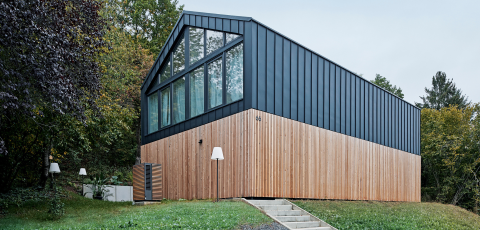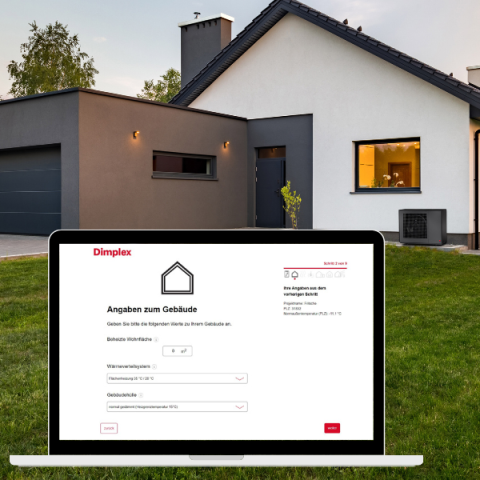
Heating and Cooling with the Heat Pump
The only heat generator that can do both.
In view of climate change and increasingly hot summers, cooling houses is becoming increasingly attractive, even in our latitudes. Anyone who decides to use a heat pump, whether in a new building or when replacing a heating system, should therefore take this option into account when planning.
In principle, a heat pump works like a refrigerator: heat is removed from the environment and is brought to a higher temperature level by compression in the heat pump using a refrigerant and then released into the environment via a so-called heat distribution system (e.g. underfloor heating, radiators).
Cooling with the Air/Water Heat Pump
In cold months, the heating water heated by the heat pump circulates in the underfloor heating, so it is comfortably warm. For cooling, the function of the air/water heat pump's refrigeration circuit is reversed and then works reversibly via the four-way valve built into the refrigeration circuit. By switching, pleasantly cool water is sent through the underfloor heating and thus lowers the room temperature. With air/water heat pumps, the heat extracted from the building is released into the environment via the fan.
There are two ways to use heat pumps for cooling: passive or active cooling. The solutions provide different benefits.
Active Cooling with the Heat Pump
The principle of active cooling with a heat pump is in principle possible with any heat pump. Air/water heat pumps can only provide active cooling because the heat source, outside air, is too warm for passive cooling in summer.
With active cooling, the functionality of the heat pump is simply reversed using an integrated four-way valve. With this method, the compressor is in operation and the heat pump can ensure permanently low cooling water temperatures compared to passive cooling.
The operating costs for active cooling are higher than for passive cooling because the compressor continues to operate. In such a case, it makes sense to combine it with a photovoltaic system, as the electricity is needed exactly when the sun is shining. In this way, the share of self-generated electricity is also increased in the summer months.
Passive Cooling with Brine or Water/Water Heat Pumps
So-called passive cooling (also natural cooling) with brine or water/water heat pumps uses the lower temperatures of the ground or groundwater all year round for cooling. With the brine/water heat pump, the brine liquid removes the heat from the heating circuit via a heat exchanger and leads it to the geothermal probe. With water/water heat pumps, the groundwater takes on this task. It is sufficient if only the circulation pumps run in both the heating circuit and the heat source; the compressor does not have to run (passive). The technical and financial effort during installation and the operating costs for passive cooling with the heat pump are relatively low. As a rule, good temperature control of the interior spaces can be achieved, but the actual cooling performance depends very much on the dimensions of the heat source.
A positive side effect here is that the geothermal probes regenerate themselves through the heat supplied from the living spaces. This increases the efficiency of the heat pump for heating operation.
What conditions need to be created?
If a heat pump is also to be used for cooling, the rest of the heating system must be coordinated accordingly. Conventional heaters (radiators) are not suitable for cooling because their small surface area means they can only cool the room air to a limited extent. There is also an increased risk of condensation forming.
Silent Cooling
With so-called silent cooling, floor, wall and ceiling heating systems are also used for cooling. Due to the large transfer areas, no active fan support is required and there is no noise (silent). The cooling water temperature must be kept above the dew point to avoid condensation. In the rooms to be cooled, an intelligent room temperature controller (Smart RTC) monitors the room temperature and humidity. The required heating mixer then automatically keeps the cooling water temperature above the dew point calculated by the heat pump manager. Silent cooling is ideal for counteracting gradual warming of the building.
Dynamic Cooling
Higher cooling performance can be achieved with fan coil units. By actively supporting heat transfer with fans, more cooling power can be transferred even at high humidity. The cooling water temperatures are below the dew point and the room air is cooled and dehumidified. The noticeable condensate must be drained away via a condensate drain.
Condensation
With dynamic cooling, all pipes and distributors must be equipped with vapor diffusion-tight insulation so that the pipes do not “sweat”.
The avoidance or removal of condensation must be taken into account during project planning.
With silent cooling, the temperature after the heating circuit mixer is kept above the calculated dew point. An additional dew point monitor attached to the distributors interrupts the cooling operation if condensation occurs there, for example due to high humidity.
How environmentally friendly is cooling with a heat pump?
A heat pump does not use fossil fuels, but rather environmental energy from air, soil or groundwater, which it multiplies with electrical energy. As a result, their operation is very low in emissions and is even completely climate neutral when purchasing green electricity or using your own electricity via the PV system. It doesn't matter whether you heat or cool with your heat pump.
Switching the Heat Pump to Cooling
The heat pump manager can activate cooling mode via the automatic operating mode switch if the outside temperature exceeds the adjustable outside temperature value for a longer period of time. Of course, manual intervention is also possible using the controller on the device or the mobile app.
Is it possible to retrofit the cooling system?
Retrofitting silent cooling is possible under certain conditions. Normal radiators are unsuitable for cooling. Replacing the radiators with fan coil units is conceivable if they are dimensioned so that they can be operated with cooling water temperatures above the dew point.
The cooling function is best integrated into the existing system right from the start. The surface heating systems are then preferably used for heating and cooling. This way, every room can be cooled. The cool surfaces ensure that rooms are at a pleasant temperature without any drafts and are completely silent.
Plan and Install Heat Pump with Cooling
Regardless of whether heat pumps are used for heating or cooling: heat pumps are suitable for almost every building situation. The choice of the right heat pump depends on the space available in the building or on the property, the building's energy requirements and the development situation.
Professional planning by the tradesman is important for the long-term satisfaction and fulfillment of the needs of the residents. Dimplex offers a wide portfolio of suitable products for every application in the area of heating and cooling.


